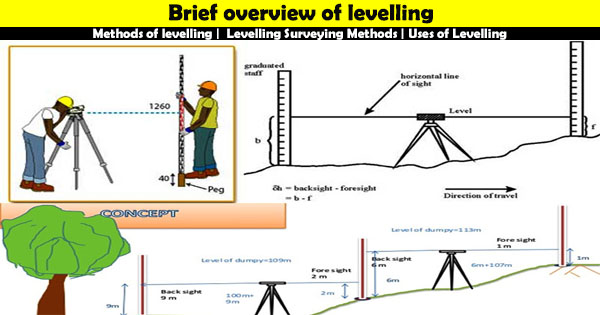Brief overview of levelling

Levelling is a division of surveying. Levelling belongs to the art of defining and demonstrating the proportionate heights or elevations of different points on the surface of earth. It is carried out for the following purposes:-
i) To determine the elevations of specified points regarding a certain or anticipated datum
ii) To settle points at a certain or anticipated datum.
The first one is essential to help in designing the work whereas the second one is essential in organizing all types of engineering works. Levelling is suitable for measurements in a vertical plane.
Level surface: A level surface stands for a curved surface that is set at each point and is perpendicular to the direction of gravity at the point. As for example, the surface of a still water belongs to an accurately level surface. Any surface analogous to the base spheroidal surface of the earth is defined as a level surface.
Level line: It is a line tangential to a level surface at a specific point. So, it is, normal to the plumb line at each and every point.
Horizontal plane: Horizontal plane via a point refers to a plane tangential to the level surface at that point. So, it is perpendicular to the plumb line via the point.
Horizontal line: It refers to a straight line tangential to the level line at a point. It is also orthogonal to the plumb line.
Vertical line: This line is normal to the level line at a point. It is generally taken as the line determined with a plumb line.
Datum: Datum belongs to any surface to which elevation is applied. The mean sea level provides a suitable datum all through the world, and elevations are generally set as so much over or under sea level. It is more suitable frequently to adopt some other datum, specially, if only the comparative elevation of points is necessary.
Elevation: The elevation of a point on or adjacent to the surface of the earth belongs to its vertical distance over or under an arbitrarily anticipated level surface or datum. The difference in elevation between two points belongs to the vertical distance among the two level surface in which the two points rest.
Vertical angle: Vertical angle belongs to an angle among two intersecting lines in a vertical plane. Usually, one of these lines is horizontal.
Mean sea level: It stands for the average height of the sea toward all phases of the tides. At any specific place it is obtained by making average of the hourly tide heights across a long period of 19 years.
Bench Mark: It stands for a comparatively permanent point of reference whose elevation with regard to some anticipated datum is identified. It is applied either as a starting point for levelling or as a point upon which to close as a check.
Methods of levelling
Three fundamental methods are applied for finding out the variations in elevation which range from barometric levelling, trigonometric levelling and spirit levelling.
To read the complete article, go through the following article.
www.civileblog.com

